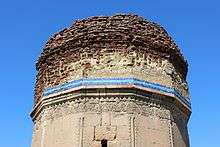Mausoleum of Kara Koyunlu emirs
| Mausoleum of Turkmen emirs | |
|---|---|
|
Southeast façade of the Emir Pir-Hussein Mausoleum in Argavand | |
 Shown within Armenia | |
| Basic information | |
| Location |
Argavand, Ararat Province, |
| Geographic coordinates | 40°09′23″N 44°26′23″E / 40.156328°N 44.439759°ECoordinates: 40°09′23″N 44°26′23″E / 40.156328°N 44.439759°E |
| Affiliation | Islam |
| Architectural description | |
| Architectural type | Mausoleum/funerary tower |
| Architectural style | Islamic |
| Completed | 1413 |
| Specifications | |
| Direction of façade | east |
| Dome(s) | 1 |
| Materials | Tuff (tower), brick (dome), blue glazed ceramic tile (decorative trim) |
The Mausoleum of Kara Koyunlu emirs or Mausoleum of Turkmen emirs (Emir Pir-Hussein Mausoleum), is a Kara Koyunlu mausoleum erected in 1413. It is located in the village of Argavand in the Ararat Province, at the outskirts of the Armenian capital Yerevan.[1]
Architecture

The Qara Qoyunlu mausoleum is decagonal in plan. Each of the monument's façades extend from the base of the tower until midway up the dome. Architecturally, it is divided into three sections; a lower section with an entry, a middle section with two windows and decorative elements, and an upper section consisting of a dome. The main body of the tower is constructed of tuff, while brick was used as the underlying material for the construction of the dome.
Decorative elements include blue and turquoise glazed ceramic tile trim that is still visible along the upper portion of the tower, just below the base of the dome and above an inscription. Below the tile trim is some decorative molding, while a frieze in bas-relief encircles the top portion of the funerary tower is inscribed in Arabic and begins with a famous sura from the Quran. It then goes on to commemorate Emir Pir-Hussein, the son of Sa'ad. The inscription says:
In the name of Allah gracious and merciful! Allah... there is no god besides Him, alive (or) real. Neither drowsiness nor sleep can seize Him. He owns everything in the heavens and on the earth. Who will plead, except with His permission? He knows what was before them and what will be after them, while they perceive nothing from His knowledge other than He wishes. His throne embraces the heavens and the earth, and He is not burdened by guarding them. Indeed great and high is He.Ordered to build this blessed tomb (kubba) the greatest, the noblest, abundant in generosity and magnanimity, the support of kings and sultans, refuge for the weak and the poor, guardian of scientists and those who seek knowledge, aid to the poor and wayfarers, the glory of the state and the faith, Emir Pir-Hussein, son of the late absolved Emir elevated to His patronage, the most merciful Emir Sa’ad… may the earth lie light upon him… in the days of the reign of the Great Sultan, the most generous Khaqan, the Sultan of Sultans in the East and the West, the aid of the state and the faith, Pir Budaq Khan and Yusef Noyän… may Allah perpetuate their power, on the fifteenth of Rajab of the year 816 (October 11, 1413).[1]
A single portal leads into the mausoleum interior. There are two small rectangular windows that are positioned at the north and south façades, centered between the upper and lower portions of the tower.
Gallery
 South façade of the mausoleum.
South façade of the mausoleum. Southwest façade of the mausoleum.
Southwest façade of the mausoleum.- West façade of the mausoleum.
 Detail of the inscription below the dome.
Detail of the inscription below the dome.- Detail of the inscription below the dome.
 Detail of the inscription below the dome.
Detail of the inscription below the dome.
References
- Brady Kiesling, Rediscovering Armenia, p. 31-32; original archived at Archive.org, and current version online on Armeniapedia.org.
External links
| Wikimedia Commons has media related to Mausoleum of Turkmen emirs. |

